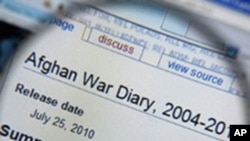The disclosure of thousands of documents by WikiLeaks about the U.S. war effort in Afghanistan set off a storm of controversy. U.S. officials decried the leak for exposing their sources of information. But there is some question about why sources' real identities were in the documents, which appear to have been widely distributed on a classified Pentagon computer network.
Some of the 90,000 classified documents published by WikiLeaks contain the names of Afghans who have provided information to U.S. forces in one form or another.
Speaking on ABC's This Week, Defense Secretary Robert Gates said the leak put those Afghans in danger, as well as the soldiers they have helped.
"I believe that this information puts those in Afghanistan who have helped us at risk," Gates said. "It puts our soldiers at risk because they [the Taliban] can learn a lot, our adversaries can learn a lot about our techniques, tactics and procedures from the body of these leaked documents. And so I think that is what puts our soldiers at risk, and then, as I say, our sources. And, you know, growing up in the intelligence business, protecting your sources is sacrosanct."
But some intelligence professionals question why the names of sources were not better protected.
Documents containing the names of sources were marked "Secret," a mid-level security classification. They then were widely distributed across a classified Pentagon computer network called "SIPRnet," a kind of classified Internet, as one analyst put it, which was set up to foster greater information-sharing within the defense and intelligence communities. Officials believe this is how the leaker got his hands on them.
Former CIA director Michael Hayden tells VOA that means the real identities of sources were available to thousands of people.
"In general, because SIPRNet is so widely available - and that is a virtue, we have been working on getting information to folks like this for more than a decade - since SIPRNet is so widely available, one would think that source identifying data would be very carefully handled," Hayden said.
The identities of intelligence sources are closely guarded secrets, even from other intelligence personnel. So reports containing sources' names would normally be "sanitized", as intelligence professionals say, to hide their true identities.
Asked why the WikiLeaks documents were not sanitized, a defense official, who asked not to be named, said this kind of tactical or battlefield intelligence gathered at the local level is not necessarily subjected to sanitizing as is done in more formal intelligence gathering.
A Pentagon spokesman says Secretary Gates has acknowledged the danger regarding source disclosure and the need to look at security procedures for forces deployed in Afghanistan, but that he also he wants to push as much information as possible as far forward as possible to the troops in the field.
Former CIA director Hayden emphasizes that the Pentagon's rules may be different than those of the CIA. But he adds that it is tough to balance the security of intelligence sources' identities with the need for analysts to know them in order to properly assess the information they provide.
"I am not calling for the widest distribution of source-identifying data," Hayden said. "But very often an analyst, to understand what gravity he wants to give to the information he has in front of him, what credibility, depends somewhat on who the source is. So you really have a dilemma here, don't you? I mean, enough data to allow the analyst to do what he has to do, but not so much that the vertent [deliberate] or inadvertent leakage of it puts somebody at risk. That is a pretty narrow sweet [optimum] spot."
The chief of tactical intelligence for the private firm Stratfor, Scott Stewart, says no one would be surprised at the names in many of the reports.
"Obviously it would have been optimal had they scrubbed the names of these people out of there," Stewart said. "And they probably did not give much thought to it of how it could endanger these people. However, for the most part from what I have seen, most of these people they are meeting with are the type of people you would expect them to meet with anyway as far government officials and village leaders and that sort of thing."
The Taliban has said it is studying the WikiLeaks documents to identify and hunt down informants who have aided U.S. forces.












